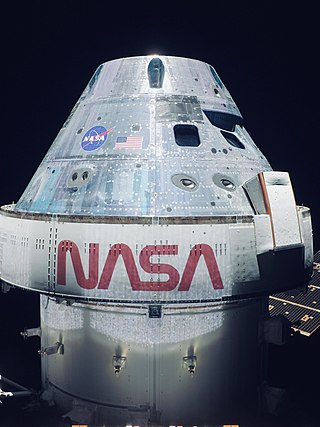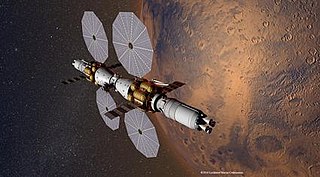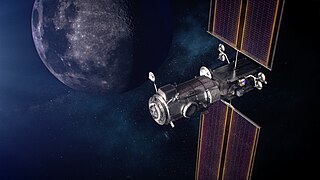Related Research Articles

The Constellation program was a crewed spaceflight program developed by NASA, the space agency of the United States, from 2005 to 2009. The major goals of the program were "completion of the International Space Station" and a "return to the Moon no later than 2020" with a crewed flight to the planet Mars as the ultimate goal. The program's logo reflected the three stages of the program: the Earth (ISS), the Moon, and finally Mars—while the Mars goal also found expression in the name given to the program's booster rockets: Ares. The technological aims of the program included the regaining of significant astronaut experience beyond low Earth orbit and the development of technologies necessary to enable sustained human presence on other planetary bodies.

The Altair spacecraft, previously known as the Lunar Surface Access Module or LSAM, was the planned lander spacecraft component of NASA's cancelled Constellation program. Astronauts would have used the spacecraft for landings on the Moon, which was intended to begin around 2019. The Altair spacecraft was planned to be used both for lunar sortie and lunar outpost missions.

The Crew Exploration Vehicle (CEV) was a component of the U.S. NASA Vision for Space Exploration plan. A competition was held to design a spacecraft that could carry humans to the destinations envisioned by the plan. The winning design was the Orion spacecraft.

A space tug is a type of spacecraft used to transfer spaceborne cargo from one orbit to another orbit with different energy characteristics. The term can include expendable upper stages or spacecraft that are not necessarily a part of their launch vehicle. However, it can also refer to a spacecraft that transports payload already in space to another location in outer space, such as in the Space Transportation System concept. An example would be moving a spacecraft from a low Earth orbit (LEO) to a higher-energy orbit like a geostationary transfer orbit, a lunar transfer, or an escape trajectory.

Orion is a partially reusable crewed spacecraft used in NASA's Artemis program. The spacecraft consists of a Crew Module (CM) space capsule designed by Lockheed Martin and the European Service Module (ESM) manufactured by Airbus Defence and Space. Capable of supporting a crew of four beyond low Earth orbit, Orion can last up to 21 days undocked and up to six months docked. It is equipped with solar panels, an automated docking system, and glass cockpit interfaces modeled after those used in the Boeing 787 Dreamliner. A single AJ10 engine provides the spacecraft's primary propulsion, while eight R-4D-11 engines, and six pods of custom reaction control system engines developed by Airbus, provide the spacecraft's secondary propulsion. Orion is intended to be launched atop a Space Launch System (SLS) rocket, with a tower launch escape system.

Artemis 3 is planned to be the first crewed Moon landing mission of the Artemis program and the first crewed flight of the Starship HLS lander. Artemis 3 is planned to be the second crewed Artemis mission and the first American crewed lunar landing since Apollo 17 in December 1972. In December 2023, the Government Accountability Office reported that the mission is not likely to occur before 2027; as of January 2024, NASA officially expects Artemis 3 to launch no earlier than September 2026 due to issues with the valves in Orion's life support system.

Mars Base Camp (MBC) is a crewed Mars laboratory orbiter concept under study that was commissioned by NASA from Lockheed Martin in US. It would use both future and proven concepts as well as the Orion MPCV, also built by Lockheed Martin.

The Deep Space Transport (DST), also called Mars Transit Vehicle, is a crewed interplanetary spacecraft concept by NASA to support science exploration missions to Mars of up to 1,000 days. It would be composed of two elements: an Orion capsule and a propelled habitation module. As of late 2019, the DST is still a concept to be studied, and NASA has not officially proposed the project in an annual U.S. federal government budget cycle. The DST vehicle would depart and return from the Lunar Gateway to be serviced and reused for a new Mars mission.

The Lunar Gateway, or simply Gateway, is a space station which Artemis program participants plan to assemble in an orbit near the Moon. The Gateway is intended to serve as a communication hub, science laboratory, and habitation module for astronauts. It is a multinational collaborative project: participants include NASA, the European Space Agency (ESA), the Japan Aerospace Exploration Agency (JAXA), the Canadian Space Agency (CSA) and the Mohammed Bin Rashid Space Centre (MBRSC). The Gateway is planned to be the first space station beyond low Earth orbit.

Blue Moon is a family of lunar landers and their associated infrastructure, intended to carry humans and cargo to the Moon, under development by a consortium led by Blue Origin and including Lockheed Martin, Draper, Boeing, Astrobotic, and Honeybee Robotics. Two versions of Blue Moon are under development: a robotic lander planned to land on the Moon in 2024, and a larger human lander planned to land a crew of four astronauts on the lunar surface for the NASA Artemis V mission in 2029.

The Artemis program is a Moon exploration program that is led by the United States' National Aeronautics and Space Administration (NASA) and was formally established in 2017 via Space Policy Directive 1. The Artemis program is intended to reestablish a human presence on the Moon for the first time since the Apollo 17 moon mission in 1972. The program's stated long-term goal is to establish a permanent base on the Moon to facilitate human missions to Mars.

Artemis 5 is the fifth planned mission of NASA's Artemis program and the first crewed flight of the Blue Moon lander. The mission will launch four astronauts on a Space Launch System rocket and an Orion to the Lunar Gateway and will be the third lunar landing of the Artemis program. In addition, Artemis V will also deliver two new elements to the Gateway Space Station.

The Boeing Human Landing System (HLS) was the name of a proposed lunar lander concept by Boeing that was submitted by Boeing to NASA on 5 November 2019 as part of the Artemis program and the NextSTEP H. The proposal was presented as the "quickest and simplest method" for a 2024 Moon landing. The lunar lander concept was not selected for funding by NASA as part of Artemis in the 30 April 2020 announcement.

Starship HLS is a lunar lander variant of the Starship spacecraft that is slated to transfer astronauts from a lunar orbit to the surface of the Moon and back. It is being designed and built by SpaceX under the Human Landing System contract to NASA as a critical element of NASA's Artemis program to land a crew on the Moon.
The Integrated Lander Vehicle (ILV) was a human spaceflight lunar lander design concept proposed in 2020/21 for the NASA Human Landing System (HLS) component of the Artemis program. Blue Origin was the lead contractor for the multi-element lunar lander that was to include major components from several large US government space contractors including Lockheed Martin, Northrop Grumman, and Draper Laboratory.

The Power and Propulsion Element (PPE), previously known as the Asteroid Redirect Vehicle propulsion system, is a planned solar electric ion propulsion module being developed by Maxar Technologies for NASA. It is one of the major components of the Lunar Gateway. The PPE will allow access to the entire lunar surface and a wide range of lunar orbits and double as a space tug for visiting craft.
A Human Landing System (HLS) is a spacecraft in the U.S. National Aeronautics and Space Administration's (NASA) Artemis program that is expected to land humans on the Moon. These are being designed to convey astronauts from the Lunar Gateway space station in lunar orbit to the lunar surface, sustain them there, and then return them to the Gateway station. As of 2024 NASA intends to use Starship HLS for Artemis III, an enhanced Starship HLS for Artemis IV, and a Blue Origin HLS for Artemis V.
References
- 1 2 3 4 5 6 7 8 9 10 11 12 13 Cichan, Timothy; Bailey, Stephen A.; et al. (1–5 October 2018). Concept for a Crewed Lunar Lander Operating from the Lunar Orbiting Platform-Gateway (PDF). 69th International Astronautical Congress. Bremen, Germany: International Astronautical Federation . Retrieved 31 May 2019.
- 1 2 3 4 5 6 7 8 9 Berger, Eric (3 October 2018). "Lockheed Martin proposes a mega-lunar lander: 62 tons and an elevator". Ars Technica . Retrieved 31 May 2019.
- 1 2 3 4 5 "Lockheed Martin Reveals New Human Lunar Lander Concept". Lockheed Martin (Press release). 3 October 2018. Retrieved 31 May 2019.
- ↑ Smith, Heather (11 April 2019). "Lockheed Martin unveils Orion-based Moon lander concept". SpaceFlight Insider. Retrieved 31 May 2019.
- 1 2 3 "Lunar Lander Proposal Unveiled by Lockheed Martin". Technology.org. 4 October 2018. Retrieved 31 May 2019.
- ↑ "Lockheed Martin Reveals Crewed Lunar Lander Concept" (Press release). Defense Media Network. 6 October 2018. Retrieved 31 May 2019.